|
The following article is copied from the 1975-1976 Illinois Bluebook:
Kaskaskia
Illinois was admitted to the Federal Union as the twenty-first state on December
3, 1818. Since that historic date, Illinois has been governed from three
different cities and from six Capitol buildings, one leased and the rest
state-owned.
Kaskaskia, which had served as the Territorial seat of government since 1809,
became the first Illinois State Capital. Founded in 1703 by French Jesuits, this
city had long played a prominent role in the history of the Illinois country and
was one of the most important settlements in the Territory.
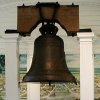 On July 4, 1778 George Rogers Clark
and his "Kentucky Long Knives" captured Kaskaskia
from the British and Illinois subsequently became a county of Virginia. Clark's
important engagements in Illinois during the American Revolution secured the
entire Northwest Territory for the newly-created United States. The
"Liberty Bell of the West", pictured here, was rung by the residents of
Kaskaskia in celebration of Clark's liberation of the town from the British.
The bell was a gift from King Louis XV of France to the Catholic Church of
the Illinois Country. The bell was cast in 1741 and arrived in Kaskaskia
via New Orleans and the Mississippi River in 1743. On July 4, 1778 George Rogers Clark
and his "Kentucky Long Knives" captured Kaskaskia
from the British and Illinois subsequently became a county of Virginia. Clark's
important engagements in Illinois during the American Revolution secured the
entire Northwest Territory for the newly-created United States. The
"Liberty Bell of the West", pictured here, was rung by the residents of
Kaskaskia in celebration of Clark's liberation of the town from the British.
The bell was a gift from King Louis XV of France to the Catholic Church of
the Illinois Country. The bell was cast in 1741 and arrived in Kaskaskia
via New Orleans and the Mississippi River in 1743.
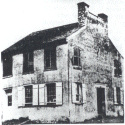 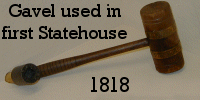 The first Capitol, a
two-story brick building, was rented by the new State government at a rate of
$4.00 a day. The House of Representatives, consisting of twenty-nine
legislators, occupied the entire first floor while the State's fourteen Senators
met in the chamber directly above. The First General Assembly petitioned
Congress for a grant of land somewhere in the State's interior to serve as the
site of a new Capital. After the request was granted, a committee of five
selected a site located some eighty miles northeast of Kaskaskia along the
Kaskaskia River. This site, then known as Reeve's Bluff, became the city of
Vandalia, our second Capital city. The first Capitol, a
two-story brick building, was rented by the new State government at a rate of
$4.00 a day. The House of Representatives, consisting of twenty-nine
legislators, occupied the entire first floor while the State's fourteen Senators
met in the chamber directly above. The First General Assembly petitioned
Congress for a grant of land somewhere in the State's interior to serve as the
site of a new Capital. After the request was granted, a committee of five
selected a site located some eighty miles northeast of Kaskaskia along the
Kaskaskia River. This site, then known as Reeve's Bluff, became the city of
Vandalia, our second Capital city.
The removal of the Capital to Vandalia had been brought about by land
speculators, including some of the State's most prominent men, who felt that
they could profit by instigating land booms in the unsettled areas.
 After Vandalia became the Capital in 1820, Kaskaskia declined in importance and
gradually disappeared under the waters of the Mississippi River. In 1881, a
sudden change in the course of the Mississippi washed away much of the ancient
Illinois Capital and created Kaskaskia Island. Succeeding spring floods have
further eroded the site until only a small farm community exists today on the
remaining portion of the site, the only existing trace of the once flourishing
State Capital. The picture to the right shows the first Statehouse in
1899, two years before it was completely swallowed by the Mississippi River. After Vandalia became the Capital in 1820, Kaskaskia declined in importance and
gradually disappeared under the waters of the Mississippi River. In 1881, a
sudden change in the course of the Mississippi washed away much of the ancient
Illinois Capital and created Kaskaskia Island. Succeeding spring floods have
further eroded the site until only a small farm community exists today on the
remaining portion of the site, the only existing trace of the once flourishing
State Capital. The picture to the right shows the first Statehouse in
1899, two years before it was completely swallowed by the Mississippi River.
Vandalia
A plain, two-story frame structure was built in Vandalia to house the State
government. The lower floor consisted of a single room for the House of
Representatives. The second floor was divided into two rooms, the larger
reserved for the Senate and the smaller one used for the meetings of the Council
of Revision. The Secretary of State, Auditor and Treasurer maintained rented
offices separate from the main Capitol building.
The Second General Assembly first met in the newly-built Capitol on December 4,
1820, During this first sitting an act was passed making Vandalia the seat of
government for the next twenty years.
 After fire destroyed the
first state-owned Capitol, a second building was erected in the summer of 1824
at a cost of $15,000. Soon after, a movement began pushing for the removal of
the Capital to some site nearer the geographical center of the State. Responding
to this growing sentiment, the General Assembly passed an act in 1833 enabling
voters to decide the location of the new Capital city at the next general
election. After fire destroyed the
first state-owned Capitol, a second building was erected in the summer of 1824
at a cost of $15,000. Soon after, a movement began pushing for the removal of
the Capital to some site nearer the geographical center of the State. Responding
to this growing sentiment, the General Assembly passed an act in 1833 enabling
voters to decide the location of the new Capital city at the next general
election.
 The sites to be voted on were Vandalia, Jacksonville, Springfield, Peoria, Alton
and the State's geographical center. Although Alton received the most votes at
the general election, the slim margin was inconclusive and the results were
never officially announced. Therefore, the suggested removal from Vandalia was
shelved until the 1836-37 session of the General' Assembly, The sites to be voted on were Vandalia, Jacksonville, Springfield, Peoria, Alton
and the State's geographical center. Although Alton received the most votes at
the general election, the slim margin was inconclusive and the results were
never officially announced. Therefore, the suggested removal from Vandalia was
shelved until the 1836-37 session of the General' Assembly,
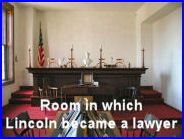 The Representative from Sangamon County, a young lawyer named Abraham Lincoln,
introduced a bill calling for the transferal of the Capital to Springfield. His
bill was actively supported by eight legislative colleagues, and together they
were known as the "Long Nine" because their aggregate height was fifty-four
feet. The Representative from Sangamon County, a young lawyer named Abraham Lincoln,
introduced a bill calling for the transferal of the Capital to Springfield. His
bill was actively supported by eight legislative colleagues, and together they
were known as the "Long Nine" because their aggregate height was fifty-four
feet.
Vandalia residents, alarmed at the mood of the Assembly, were determined to
retain the Capital. During the Legislature’s recess in the summer of 1836, they
tore down the twelve-year-old Capitol building and replaced it with a brick
State House costing $16,000. However, this extravagant gesture proved to be
entirely in vain. Upon the return of the General Assembly, ignoring Vandalia's
efforts, Lincoln succeeded in having Springfield named as the third Illinois
Capital.
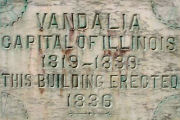 On February 25, 1837, the Assembly authorized the Capital's removal from
Vandalia to some place nearer the State's geographical center. Three days later
Springfield was the site chosen. Because of the 1820 Assembly Act, Vandalia was
to legally continue as the Capital until December 1, 1840. However, Governor
Thomas Carlin issued a proclamation ordering the removal of all State records to
Springfield by July 4, 1839. The State government began functioning in
Springfield during December, 1839. On February 25, 1837, the Assembly authorized the Capital's removal from
Vandalia to some place nearer the State's geographical center. Three days later
Springfield was the site chosen. Because of the 1820 Assembly Act, Vandalia was
to legally continue as the Capital until December 1, 1840. However, Governor
Thomas Carlin issued a proclamation ordering the removal of all State records to
Springfield by July 4, 1839. The State government began functioning in
Springfield during December, 1839.
The Eleventh General Assembly returned the Vandalia Capitol to Fayette County.
In 1919, the State repurchased the building and in 1933 to converted it into a
State memorial. Since then, the Old State House has been open to the public as a
reminder to Illinoisans of the expensive folly of the early Vandalia citizens.
Springfield
 The cornerstone of the State's fifth Capitol was laid at Springfield on July 4,
1837. The principal speaker at the ceremony was Edward D. Baker, a Springfield
lawyer and probably Lincoln's most intimate friend. In 1860, Baker was elected
the first United States Senator from Oregon and died a Civil War hero in 1861.
After repeated delays, the Capitol was finally completed in 1853. The total
cost, $260,000, was double the original estimate. The cornerstone of the State's fifth Capitol was laid at Springfield on July 4,
1837. The principal speaker at the ceremony was Edward D. Baker, a Springfield
lawyer and probably Lincoln's most intimate friend. In 1860, Baker was elected
the first United States Senator from Oregon and died a Civil War hero in 1861.
After repeated delays, the Capitol was finally completed in 1853. The total
cost, $260,000, was double the original estimate.
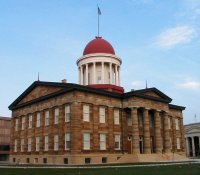 The Greek Revival-style building, constructed of stone brought from a quarry
only six miles away, was the most imposing state capitol in the west for many
years. The building has abundant Lincoln associations. In addition to attending
legislative sessions in the building, he sometimes argued cases before the
Supreme Court which also met in the Capitol. It was in the Old Capitol that
Lincoln first confronted Stephen A. Douglas, his rival for the Presidency in
1860; here Lincoln made his famous "House Divided" speech and maintained an
office after election to the Presidency in 1860; and, finally, it was here that
his body rested on May 3-4, 1865, before burial at Oak Ridge. The Greek Revival-style building, constructed of stone brought from a quarry
only six miles away, was the most imposing state capitol in the west for many
years. The building has abundant Lincoln associations. In addition to attending
legislative sessions in the building, he sometimes argued cases before the
Supreme Court which also met in the Capitol. It was in the Old Capitol that
Lincoln first confronted Stephen A. Douglas, his rival for the Presidency in
1860; here Lincoln made his famous "House Divided" speech and maintained an
office after election to the Presidency in 1860; and, finally, it was here that
his body rested on May 3-4, 1865, before burial at Oak Ridge.
|

